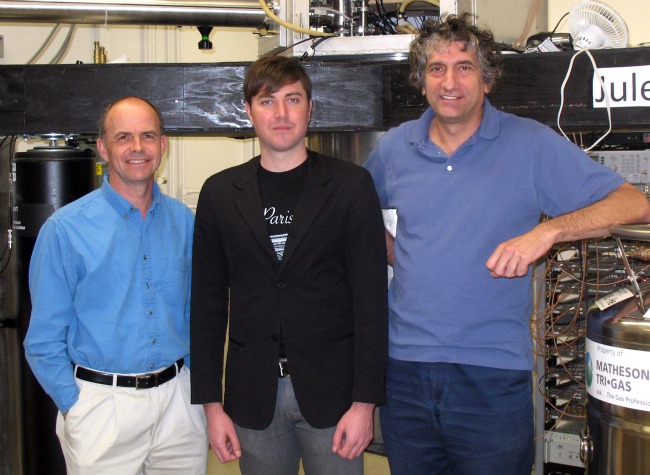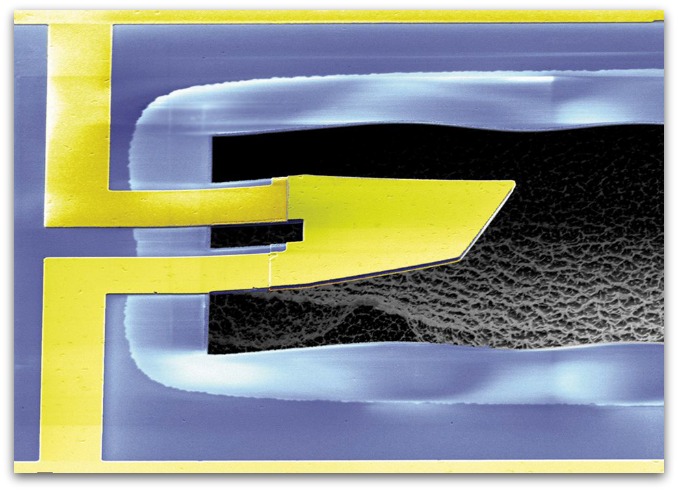Research by UCSB Physicists Honored as Science’s 2010 Breakthrough of the Year
Magazine calls this discovery "the most significant scientific advance of 2010"
A quantum device designed by a team of UC Santa Barbara physicists led by Andrew Cleland and John Martinis has been named the 2010 Breakthrough of the Year by the journal Science.

Science, the publication of the American Association for the Advancement of Science, cited the UCSB researchers for designing “a gadget that moves in ways that can only be described by quantum mechanics –– the set of rules that governs the behavior of tiny things like molecules, atoms, and subatomic particles. In recognition of the conceptual ground this experiment breaks, the ingenuity behind it, and its many potential applications, Science has called this discovery the most significant scientific advance of 2010.”
The Science editors added: “Physicists Andrew Cleland and John Martinis from the University of California, Santa Barbara and their colleagues designed the machine –– a tiny metal paddle of semiconductor, visible to the naked eye –– and coaxed it into dancing with a quantum groove. First, they cooled the paddle until it reached its ‘ground state,’ or the lowest energy state permitted by the laws of quantum mechanics (a goal long-sought by physicists). They then raised the widget’s energy by a single quantum to produce a purely quantum-mechanical state of motion.”

Commenting on the announcement, UCSB Chancellor Henry T. Yang said: “Our entire campus community takes great pride in the pioneering achievement of Professors Andrew Cleland and John Martinis and their research team. For AAAS and Science magazine to recognize their quantum device as the 2010 Breakthrough of the Year is a testament to the tremendous significance of their work, which is leading the world to a new understanding of quantum mechanics.”
Cleland, who learned of the honor December 16, said: “A key to getting this experiment to work was the hard work and ingenuity of Aaron O’Connell, who is a graduate student in our effort, and without whom we may not have been able to achieve the marvelous results that have attracted so much attention.”
Martinis, who holds the Susan and Bruce Worster Chair in Experimental Physics at UCSB, added: “We were quite surprised by the attention this result has achieved in the media, and are humbled by the comparison of our work to the other scientific achievements in the past year.”
The research by the UCSB physicists was No. 1 in Science‘s top 10 research highlights of 2010. The complete list is included in the issue released in December.
“To bring quantum physics into the macroscopic world required a tour de force of experimental technique,” said Michael Witherell, UCSB’s vice chancellor of research. “It is not surprising that Science magazine named it the Breakthrough of the Year across all of science.”
Adrian Cho, a news writer for Science, explained the importance of the research in Science’s article: “This year’s Breakthrough of the Year represents the first time that scientists have demonstrated quantum effects in the motion of a human-made object. On a conceptual level, that’s cool because it extends quantum mechanics into a whole new realm. On a practical level, it opens up a variety of possibilities ranging from new experiments that meld quantum control over light, electrical currents and motion to, perhaps someday, tests of the bounds of quantum mechanics and our sense of reality.”
When asked by a reporter about the practical uses of a quantum device, Martinis said: “Quantum mechanics has traditionally been thought of as the physics of small, elementary objects, like electrons or atoms. Our work shows that this quantum wave description of matter also works for macroscopic objects made up of billions of atoms, like mechanical oscillators. This and other work enables physicists to go beyond the study of natural quantum systems, to build new ‘quantum integrated circuits’ based on nanofabrication technology.”
Both Cleland and Martinis point out that their research is part of a larger effort to build a quantum computer using superconductors. In addition, Cleland has a program to use the mechanical resonator to connect a superconducting quantum system to optical light.
This research was first reported in the March 17, 2010 issue of the online journal Nature, and in a UCSB press release issued the same day.
